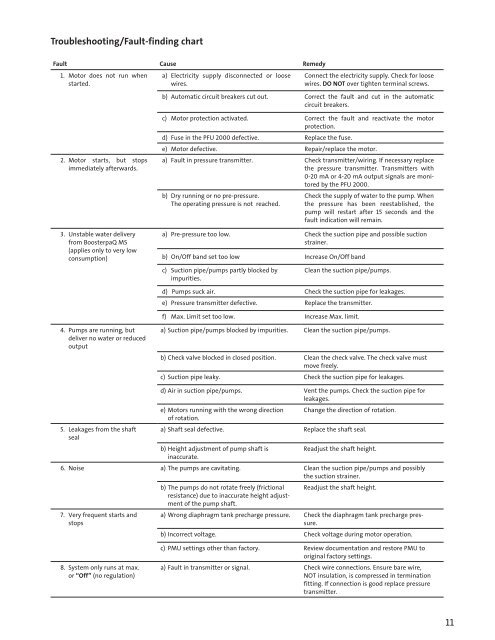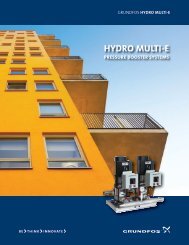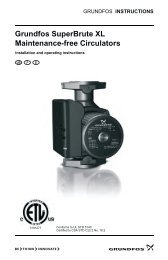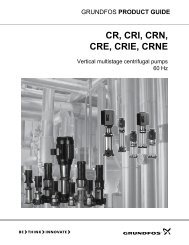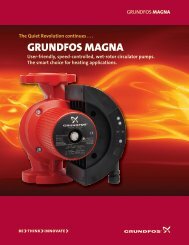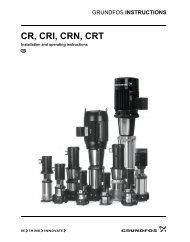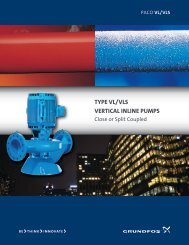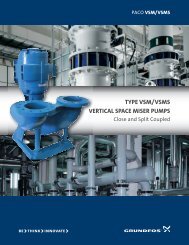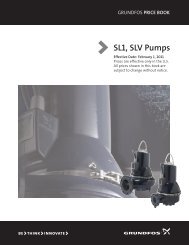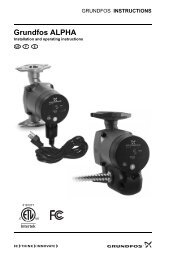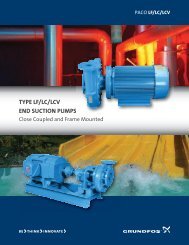BoosterpaQ® Grundfos CR-Booster Systems 60 Hz
BoosterpaQ® Grundfos CR-Booster Systems 60 Hz
BoosterpaQ® Grundfos CR-Booster Systems 60 Hz
Create successful ePaper yourself
Turn your PDF publications into a flip-book with our unique Google optimized e-Paper software.
Troubleshooting/Fault-finding chart<br />
Fault Cause Remedy<br />
1. Motor does not run when<br />
started.<br />
a) Electricity supply disconnected or loose<br />
wires.<br />
Connect the electricity supply. Check for loose<br />
wires. DO NOT over tighten terminal screws.<br />
b) Automatic circuit breakers cut out. Correct the fault and cut in the automatic<br />
circuit breakers.<br />
2. Motor starts, but stops<br />
immediately afterwards.<br />
3. Unstable water delivery<br />
from <strong>Booster</strong>paQ MS<br />
(applies only to very low<br />
consumption)<br />
c) Motor protection activated. Correct the fault and reactivate the motor<br />
protection.<br />
d) Fuse in the PFU 2000 defective. Replace the fuse.<br />
e) Motor defective. Repair/replace the motor.<br />
a) Fault in pressure transmitter. Check transmitter/wiring. If necessary replace<br />
the pressure transmitter. Transmitters with<br />
0-20 mA or 4-20 mA output signals are monitored<br />
by the PFU 2000.<br />
b) Dry running or no pre-pressure.<br />
The operating pressure is not reached.<br />
Check the supply of water to the pump. When<br />
the pressure has been reestablished, the<br />
pump will restart after 15 seconds and the<br />
fault indication will remain.<br />
a) Pre-pressure too low. Check the suction pipe and possible suction<br />
strainer.<br />
b) On/Off band set too low Increase On/Off band<br />
c) Suction pipe/pumps partly blocked by<br />
impurities.<br />
Clean the suction pipe/pumps.<br />
d) Pumps suck air. Check the suction pipe for leakages.<br />
e) Pressure transmitter defective. Replace the transmitter.<br />
f) Max. Limit set too low. Increase Max. limit.<br />
4. Pumps are running, but<br />
deliver no water or reduced<br />
output<br />
a) Suction pipe/pumps blocked by impurities. Clean the suction pipe/pumps.<br />
b) Check valve blocked in closed position. Clean the check valve. The check valve must<br />
move freely.<br />
c) Suction pipe leaky. Check the suction pipe for leakages.<br />
5. Leakages from the shaft<br />
seal<br />
d) Air in suction pipe/pumps. Vent the pumps. Check the suction pipe for<br />
leakages.<br />
e) Motors running with the wrong direction Change the direction of rotation.<br />
of rotation.<br />
a) Shaft seal defective. Replace the shaft seal.<br />
b) Height adjustment of pump shaft is<br />
Readjust the shaft height.<br />
inaccurate.<br />
6. Noise a) The pumps are cavitating. Clean the suction pipe/pumps and possibly<br />
the suction strainer.<br />
b) The pumps do not rotate freely (frictional<br />
resistance) due to inaccurate height adjustment<br />
of the pump shaft.<br />
Readjust the shaft height.<br />
7. Very frequent starts and<br />
stops<br />
a) Wrong diaphragm tank precharge pressure. Check the diaphragm tank precharge pressure.<br />
b) Incorrect voltage. Check voltage during motor operation.<br />
8. System only runs at max.<br />
or “Off” (no regulation)<br />
c) PMU settings other than factory. Review documentation and restore PMU to<br />
original factory settings.<br />
a) Fault in transmitter or signal. Check wire connections. Ensure bare wire,<br />
NOT insulation, is compressed in termination<br />
fitting. If connection is good replace pressure<br />
transmitter.<br />
11


